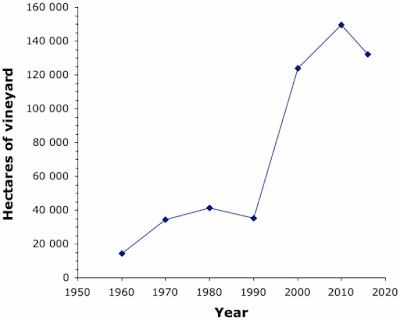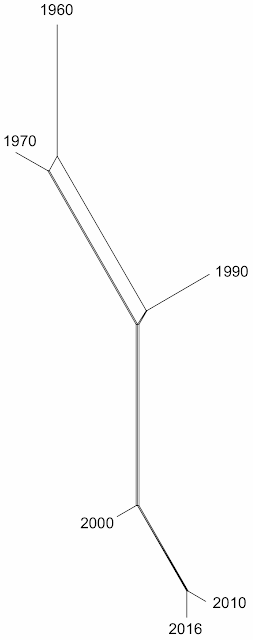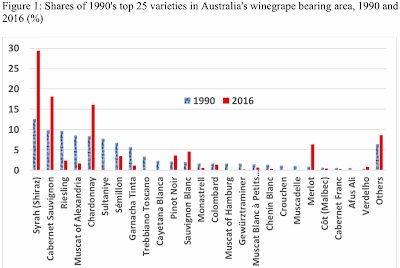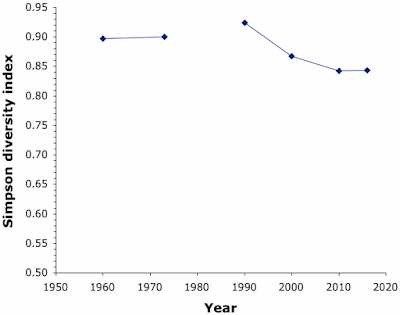Monday, October 26, 2020
Should we worry about Artificial Intelligence in wine writing?
To me, the important point to note is that two human beings were actually involved in producing the article — and none of us would bother reading it if there had been no people involved at all. Being human is a rather human activity, which means that it is based on social interactions. Humans interact with other humans by choice. If things are done by machine, then they have no especial human interest.
After all, isn't that the fundamental cause of the current second wave of the Covid-19 pandemic, in which infections are increasing to levels not seen for several months? People are thoroughly sick of all those months of "social distancing", and having to look like masked bank robbers making a getaway. They want some social human contact, such as they previously had in their lives (and which they one day will have again). So, the restaurants and bars are full, and the young people are partying again. The virus loves it. (For an interesting discussion of the psychology of our current pandemic responses, see: Acedia: the lost name for the emotion we’re all feeling right now.)
So, should we worry about AI in wine writing? Only if the readers want no social contact with another human being. A blog post concerns human communication, for example, as do YouTube videos, FaceBook messages and Twitter tweets. The world is full of noise, of course, but in amongst it there are some real attempts at communication.
You see, the thing about AI is that it is and it isn't. It is artificial, and it isn't intelligent. Even though we call it "machine learning", the computer doesn't actually learn anything. All that most AI systems can do is take a massive amount of input data, and create an organized database that synthesizes the observed patterns of relationships among the different parts of the data. Then, when the system is later given one of the components as a new input, it produces a closely matching output. Impressive, sure, especially when the output looks natural; but human beings are not quite that mechanical — indeed, humans often need only one previous example of something, in order to correctly identify new examples.
We will, of course, be seeing many more uses of AI in the future; and I have written about some of them before (Artificial intelligence in the wine industry? Not yet, please!). Car driving is an obvious candidate, given just how bad most humans are at it. I have always thought that the most remarkable thing about people is their ability to fall asleep at the wheel. Cars can kill, as hundreds of people find out every day; and yet our minds grasp this fact so poorly that they think it is a good time to take a nap while driving. AI has the potential to alleviate the danger of this situation. Even bad AI will probably be better than many human drivers.
So, AI can be used for many things, including unexpected ones. As one interesting example, while there are specialist computer programs for playing the game of chess (eg. Deep Blue, Stockfish, AlphaZero), even a general text AI system can also do it (such as HAIMKE, referenced above) — this is called "natural language processing" (NLP). Chess moves can be written in the form of words (see Chess notation), and so a text-based AI system can be given a large collection of chess games that have previously been played. Even without any further instructions about how chess is played, after it has generated its database, it will have discovered all of The most common chess openings. Then, in response to any given chess move, it will respond with one of those opening gambits, just like a person would. The system knows nothing about chess, not even the concept of a chess board, let alone the rules of play — it simply produces what are apparently appropriate (text-based) responses to any new (text-based) input. Under these circumstances, is this system really "playing" chess?
Anyway, it seems that our children's children will be living in a different world, and this will be an AI one for sure. But I doubt that they will be reading wine writing if they know it was "written" by a computer rather than a person — there is an important difference between creative "writing" and mere "text generation". The latest NLP systems can produce some pretty remarkable performances, such as creating poetry that seems just like the real thing (see GPT-3 creative fiction); but is there much of a market for it? * AI has its obvious uses, but human communication is not one of them.
Mind you, the products of actual Wine Writers often seem far too much like repetition of the same old stuff, year after year; so I guess that the AI people will see reproducing this as pretty easy for a computer to do. Interestingly, this response might very well stimulate more creative forms of human wine writing, which would not be a bad thing. After all, this is what actually happened with chess (AI ruined chess: now, it’s making the game beautiful again).
At least this year the wine writers had some new things to write about, which is something that AI systems cannot (yet) do. However, I hope that we do not have to write about fires and pandemics too often!
* See also: Experimental evidence that people cannot differentiate AI-generated from human-written poetry.
Monday, October 19, 2020
Australia's changing vineyards
In a recent post, I discussed where various wine-grape varieties are currently grown. I noted that there is more difference between countries than similarity. This is a Good Thing in the face of global climate change, as it means that grape varietal diversity is not under immediate threat.
However, it has been noted that the vineyards of the world are changing, with some varieties becoming dominant in many regions around the world. These include the obvious international candidates, such as Cabernet Sauvignon, Chardonnay and Pinot Noir. This is probably a Bad Thing, both biologically (less diversity) and economically (more competition for the same markets).
So, it is worth having a look at some relevant data. Recently, Kym Anderson & Signe Nelgen published a report on Australia’s Declining Winegrape Varietal Distinctiveness; so, Australia seems like a good place to start, as an example of varietal changes in a New World viticultural region.
The information for this post comes from the Global megafile, National 0920 spreadsheet file of:
Anderson, K. and S. Nelgen (2020) Which Winegrape Varieties are Grown Where? A Global Empirical Picture (revised edition). University of Adelaide Press: Adelaide.The data consist of the estimated growing areas for each of 139 grape varieties, for each decade from 1960 to 2016. Sadly, the data for 1980 are seriously incomplete, as this includes only 20 varieties (compared with 41 in 1970 and 40 in 1990, for example). Since the missing varieties include obvious things like Cabernet Franc, Côt (aka Malbec), and Pinot Noir, I have left this year out of most of my analysis.
First, it is important to note that there was a rapid increase in Australia’s wine-grape bearing area between 1990 and 2000, associated with a boom in premium (bottled) wines, as shown in the next graph. It is interesting to see whether there was also a change in varietal mix during this time, or whether the same dominant varieties simply increased in area.
As in my previous post on grape varieties, I have used a network as a convenient pictorial summary of the complex varietal data. As before, I first calculated the percent of each grape variety as a component of the viticultural area, and then calculated the similarity among pairs of years using the Bray-Curtis measure (important, because it ignores varieties that do not occur in either of the two years being compared). I then used these similarities to calculate a NeighborNet network, as shown next. Years that are closely connected in the network (along the edges) are more similar to each other, in terms of their grape varietal composition, than they are to years further apart.
Well, the basic picture is pretty clear. There has been a continual change in the varietal make-up of Australia's vineyards from 1960 (at the top of the graph) until recently (2016, at the bottom). The years are, indeed, somewhat different from each other, especially 1960, but their similarities to the general pattern outweigh their differences. The 1960 sample is different because, at that time, Australia’s vineyards were often planted to high-yielding multi-purpose varieties, and wine-making was concentrated on what were then known as "sherry" styles.
The network shows that there were large changes in composition between 1970 and 1990, and also between 1990 and 2000, and apparently in the same direction. There were no differences in the number of reported varieties (1970: 42 varieties; 1990: 40 varieties; 2000: 43 varieties), but clearly the relative abundance of these varieties changed considerably. Anderson and Nelgen (cited above) note that these changes were associated with increasing dominance of the most popular grape varieties. They illustrate this using the following graph of the most abundant varieties, which shows that the area of the main international varieties increased disproportionately.
This pattern was a general one, as there was an overall decrease in varietal diversity after 1990. I calculated Simpson's Diversity Index for each year, which is a formal measure of such things. Since there was little change in the number of reported varieties through time, in this case the index will be measuring how equal were the relative grape areas — low index values indicate very uneven abundances (alternatively, index = 1 would mean that all varieties had the same growing area). The next graph shows that the index consistently decreased between 1990 and 2010, suggesting it wasn't just the main varieties involved in the change during the boom.
Notably, there was very little change in the area of the major varieties between those years, but many more grape varieties are now being recorded. For example, only 40 varieties have data for 2010 but there were 118 recorded for 2016. There is the possibility that much of this difference is simply due to more thorough data collection. However, there has also been a deliberate response to climate change, as many vignerons start to trial new varieties from (especially) dry climates around the world. These varieties are often in low abundance at the moment (eg. there are 35 varieties listed as 1–2 hectares), and it is often smaller wineries that are most interested in them, but the area will presumably expand if the trials are successful.
Next time, I will look at France and Germany, as examples of Old World viticultural changes.
Monday, October 12, 2020
Why have we left it so late to deal with climate change in the wine industry?
The basic issue for us is that wine-making relies on grapes, and grape-growing is part of agriculture, which is a practical application of biology; and there are huge parts of biology that do not happen fast — some bits do happen fast, but most bits do not. Many plants and animals grow and breed at quite a leisurely pace, in the big scheme of things. And climate change is happening faster than they can cope (eg. Fire, smoke, heat, drought — how climate change could spoil your next glass of California Cabernet).
In the modern world, we are used to trying to make things happen faster and faster. We often succeed, but that is not necessarily a Good Thing. For example, after the SARS (coronavirus) epidemic in 2002 and the following MERS (coronavirus) epidemic in 2012, a report was published with an explicit forecast of how fast the next epidemic would spread (Predictability and epidemic pathways in global outbreaks of infectious diseases: the SARS case study). Boy, did they get it right, noting in particular the importance of plane travel in making the spread happen really fast. Pandemics used to take years, now they happen in weeks; and we need to adjust to that fact.
So, modern travel accelerates that particular part of biology; and it also helps us with more useful things, like getting food from much further away than we ever could before. But what about other parts of biology? Well, many parts cannot be fast; or, at least, not that fast.
Plants usually take hundreds or thousands of years to adjust to changes in their environment. This is a very specific type of what people mean when they use the word "evolution". In biology, individual organisms themselves do not change. What happens is that there is much genetic variation among any given group of organisms, and some of these variants will be better suited than others to any new situation. These are the ones that will grow and breed, while the others die out. Slowly, bit by bit, that group of organisms will change as a whole, even though no individual within the group changes during its own lifetime.
This natural process all takes time, and lots of it. The world has been through all sorts of environmental changes, including Ice Ages and all the rest of it. These changes have been just as severe as the results of the currently observed climate change, but because they happened slowly the organism groups could adjust. Whole groups of organisms have disappeared through time, of course, not just the well-known example of dinosaurs; but the rest of us have made it, so far.
The issue, then, for the current climate change, is speed. If we are going to continue to live a life-style somewhat similar to our current one, then agriculture needs to be based on organisms that can tolerate the new regime. Many types of agricultural organisms may not be greatly affected by the new conditions, but plenty of them will be; and grapes are among them.
It is for this reason that the wine industry is ahead of much of the game. Regional conditions have always been a vital part of viticulture, in terms of the resulting wine. So, any change in those conditions becomes obvious pretty darned quickly. People cannot help but notice when their wine changes.
Therefore, much of the wine industry has at least taken notice of climate change, and parts of it are actively working on ways of dealing with it (eg. Horticulture researchers find ways to combat climate change in vineyards). What, then, is my point here? It is simply this: the viticulture part of the wine industry cannot change fast, solely because of the time needed for the grape vines. We can be speedy, but they cannot.
New cultivars
Suppose, for instance, we need new cultivars for making wine, ones that can handle the new climate conditions at any given location, and still produce grapes that ripen evenly, with good sugar and acid levels, and excellent flavor components.
Well, we first have to breed them, then we have to trial them in a few vineyards, then we have try making wine from the grapes, and work out the best wine-making style for those wines, and then get the public to decide whether they like them or not. If they do like them, then we have to propagate the vines, and disperse them among the rest of the vineyards, whether for grafting or for new plantings.
There's quite a few years right there — after all, it can take 5 years between planting vines and harvesting a decent crop of grapes. In other words, the wine industry needed to be where we are now about 20 years ago, if not more, if we are going to use new cultivars effectively.
Our current cultivars have been developed over hundreds of years. This is quite speedy compared to the natural process I described above; but half the point of agriculture has been to speed things up by doing them ourselves, rather than waiting for nature to do it for us. We select organisms from among the variants that we can see in nature around us; and we encourage particular organisms to breed, if we think they will have offspring that are of use to us (eg. Champagne growers help cultivate the grape varieties of the future).
This is fast, but it is still slow compared to a human lifespan. The wines I am drinking now are made from cultivars that were mostly derived in previous centuries, rather than during the current one. We have had quite a few human lifetimes to sort out how to make the best wines from them.
The issue, then, is that the speed of climate change is not giving us those lifetimes. We need to make changes right now, not next century. So, we need to speed-up the process of getting new cultivars; and there are biological limits to how fast we can do this.
Mind you, not everyone is pleased with this prospect, anyway. It can take scores of new cultivars to get even one that the wine-drinking public will take to. For example, Robert Joseph (The grape of things to come) has looked at a few recently derived cultivars, and he reports that neither he nor the vignerons nor the wine drinkers are too impressed with some of them. It seems that we may have a ways to go.
However, it is also possible that this response is cultural. The people referenced by Robert Joseph, including himself, obviously assumed the concept of straight varietal wines. Not all wine-making regions favor this approach, notably in Portugal and Spain, but also in Italy. For example, I recently had a wine from Bairrada DOC in Portugal (Quintas de Bágeiras Reserva 1999), which mentions no grape cultivars at all — because the wine is a blend of anything up to six cultivars, none of which you have ever heard of. The way into the future may well be this sort of blending of new cultivars, rather than reverence for a few special ones, as we currently so often do it.
Alternatives
Without moving too far from the idea of new cultivars, another practical alternative is direct genetic modification. We physically move some genetic material from one organism to another, so that the second organism now has a different genotype. That way, we don't have to wait for the organisms to breed, and make new genetic variants, as we simply create the ones we want (or think we do). This is very fast, indeed.
This form of Genetic Engineering is called transgenic genetic modification; and it is opposed by many people, and for good reason. It certainly makes my own skin crawl. The basic issue is that there is no apparent boundary to the ethics of who can do what. If I want fluorescent pigs, then I can have them (Scientists create the world's first glow-in-the-dark PIGS after injecting them with jellyfish DNA); and a lot worse, as well.
A different form of Genetic Engineering is what we call gene editing. We don't actually add new genetic material into the organism, but simply modify what is already there. Some gene-controlled features are actually based on very small changes in the genome, often just the addition or deletion of a single base-pair (the smallest unit of genetic material). If we make these small changes ourselves, then we can add or subtract quite a bit of genetically controlled behavior.
However, this is like anything — all of this can be used for good or evil; and you will get no say whatsoever in which one you get, because it will be someone else doing it (and probably funded by your own government). Genetic Engineering is best banned, in its entirety. The issues are far too complex, and there is far too little understanding about these issues, even among biologists, let alone the public (Key SA wine region leads push to remain GM-free).
An alternative that is available in many geographical regions is to use current cultivars from one region and transfer them to other regions. If Champagne and Burgundy are now too warm for Pinot noir and Chardonnay, then replace them with Cabernet sauvignon and Sémillon. Stick the Pinot noir and Chardonnay in Denmark, where they can now grow quite well. You get the idea — we still get roughly the same wines, and vignerons get to keep growing grapes. What changes is geographical location, not so much the types of wines.
This is still a pretty big change for the wine industry, of course. Our grandchildren will revere Danish wine, even if we don't (yet). I'm probably too old to see it fully, but most of you may not be.
Conclusion
I don't really have an answer to the question posed in the title, other than standard human inertia. We usually don't change anything until we are forced to — if it isn't broken, then don't fix it. However, it has become increasingly clear worldwide that something is pretty seriously broken; and we are now pretty sure that we know what it is. We also have several options for what specifically can be done in viticulture to mitigate the effects of the breakage, along with the obvious global option of trying to slow down (and even reverse) the process of climate change. The future of the wine industry does actually depend on it, whether we turn a blind eye or not.
Monday, October 5, 2020
Wine grape varieties: where in the world are they?
However, to get started, we might consider where various wine-grape varieties are grown now, before we consider any of the changes — I also had a bit of a look at this topic back in March (Which countries are similar to each other, in terms of their grape varieties?). The information for this new post comes from Table 100 of:
Anderson, K. and S. Nelgen (2020) Which Winegrape Varieties are Grown Where? A Global Empirical Picture (revised edition). University of Adelaide Press: Adelaide.

What we have here is a compilation of the estimated growing areas in the year 2016 for 300 wine-grape varieties in 50 countries. Note that China is reportedly the world's biggest grape producer, but only 11% of these grapes are used to make wine (the rest are table grapes, including raisins). Here, the focus is on wine grapes only.
This is obviously rather complicated information (300 varieties x 50 countries), and so we need some summary images, in order to grasp the overall picture.
We could start, for example, by comparing the so-called New World with the Old one. Modern viticulture proliferated in south and central Europe (the Old World) and spread from there with various colonial invasions of the other continents (the New World, although obviously the native peoples did not see it that way), principally North and South America, and Australasia, but also bits of Africa and Asia.
The following graph provides a summary of the growing area summed over the various countries of the Old World (horizontally) and the New World (vertically) for each grape variety (represented by the points). The top 12 most abundant varieties globally are highlighted in pink, and are named, except for Sangiovese (where I couldn't fit the label in), and with Côt (aka Malbec) added.
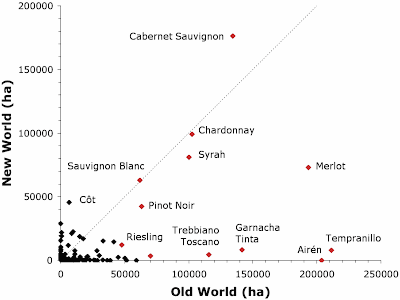
The dashed line indicates equal vineyard areas in the New and Old Worlds. Note that the New World areas of Cabernet Sauvignon and Côt (Malbec) greatly exceed those of the Old World, while for Chardonnay and Sauvignon Blanc they are about equal. For the other major varieties, the Old World areas exceed those of the New.
Cabernet Sauvignon is widespread throughout the both the New and Old Worlds, while Côt (Malbec) is mostly grown in Argentina. Syrah (aka Shiraz) is becoming more widespread in the New World, being a good candidate for many areas where the climate is becoming drier — it might soon reach equality between Old and New. Chardonnay and Sauvignon Blanc are also widespread, although the latter is particularly popular in New Zealand.
Merlot has never been as popular in the New World as it is in the Old — Cabernet was chosen to emulate the Bordeaux wines, but not Merlot. The other popular grapes from the Old World have not yet caught on elsewhere — Tempranillo and Airén from Spain, Garnacha Tinta (aka Grenache) from Spain and France, Trebbiano Toscano from France and Italy, and Sangiovese from Italy. Pinot Noir and Riesling have always been a bit specialist, even in the Old World, as they require careful handling in suitable sites, in order to produce good wines.
We can now proceed to an overall picture of the varietal makeup of the the different countries, using a more complex illustration. I have previously explained the use of networks, to display complex relationships (Summarizing multi-dimensional wine data as graphs, Part 2: networks). We cannot just lump countries together into simple groups, because they each have their own particular make-up.
To produce the network, I first calculated the percent of each grape variety as a component of the viticultural area in each country, and then calculated the similarity among pairs of countries using the Bray-Curtis measure. The latter is important because it ignores varieties that do not occur in either of the two countries being compared (otherwise, two countries would be similar because of all of the varieties neither one has). Finally, I used the similarities to calculate a NeighborNet network, as shown next (click to enlarge).
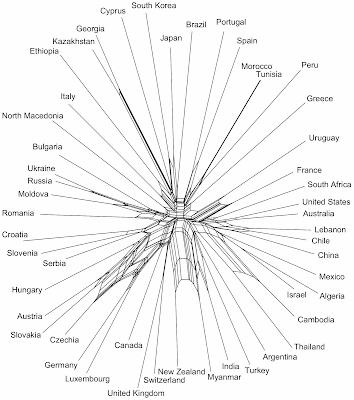
Countries that are closely connected in the network (along the edges) are more similar to each other, in terms of their grape varietal composition, than they are to countries further away.
Note, first, that all of the countries have a lot of uniqueness — the terminal edges leading to each country are much longer than are the complex of connecting edges in the middle of the network. For example, Portugal has obvious similarities to Spain, as they share 43 of the 300 listed varieties; but Spain has 42 other varieties that Portugal does not have, while Portugal has 25 that Spain does not — the differences between the two countries exceed the similarities. Moreover, countries like Greece, Cyprus and Ethiopia are very distinct. Indeed, they are each dominated by a single variety that is found in few other places.
Second, none of the countries form clear groups that are separate from other groups, except for Morocco + Tunisia, which are almost identical, sharing all 15 of their grape varieties. There are, however, quite a few neighborhoods, where countries form close connections, but these neighborhoods connect in complex ways to the other neighborhoods.
Some of these neighborhoods are geographical, but others are not. Notably, if we look at the countries of South America, we can see that they are very different in terms of grape varietal composition — clockwise from the top: Brazil, Peru, Uruguay, Chile, Argentina; even Mexico is different. New World vineyards are certainly not all the same!
Perhaps the most obvious country collection is Austria + Slovakia + Czechia, all of them having a lot of Grüner Veltliner and Graševina, along with some Sankt Laurent (which variety occurs almost nowhere else). These countries are also somewhat similar to Germany + Luxembourg, all five of them having a lot of Riesling and Müller-Thurgau.
Georgia + Kazakhstan form an obvious pair, both being dominated by the Rkatsiteli grape. Likewise, Ukraine + Russia are similar (dominated by Cabernet Sauvignon, Aligoté, and Rkatsiteli), along with Moldova (which also has a lot of Merlot, plus the Moldova grape), and also with some similarity to Romania (which has large areas of Fetească Albă and Fetească Regală instead of Rkatsiteli). Japan has obvious similarities to South Korea (based on Kyoho, and Muscat Bailey A). However, in all of these cases the differences are still bigger than the similarities.
It will come as no surprise to you that the vineyards of United States and Australia are similar, being dominated by, in particular, Cabernet Sauvignon and Chardonnay; however, they actually share 58 varieties, although they do occur in very difference abundances (Australia has another 34 non-shared varieties, and the US has 15).
On the other hand, it may surprise you that the countries with the most similar grape make-up to New Zealand are Myanmar and India. New Zealand differs from almost all other countries by being so heavily dominated by Sauvignon Blanc, comprising 58% of its vineyard area. Well, Myanmar has only 70 ha of vines, but 31% of these are Sauvignon Blanc; and India has c. 2,700 ha, with Sauvignon Blanc at 19%. Now you know!
Conclusion
The global vineyard is changing, as it always has done. New varieties have arisen in particular places, and become established as a valued part of the environment. This has progressively made old-established vineyards different from each other. As people have moved, they have taken their favorite vines with them. Some of these varieties have become popular in their new homes, but each home has been somewhat different. This also makes economic sense, of course, since there is little reason for competing head-to-head in a global marketplace, Future changes will be driven by these same impetuses.




